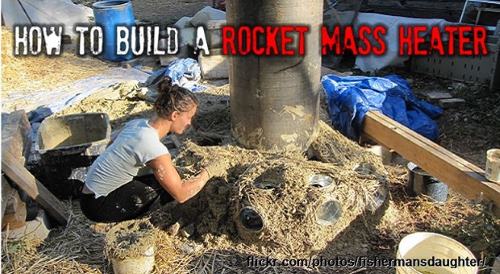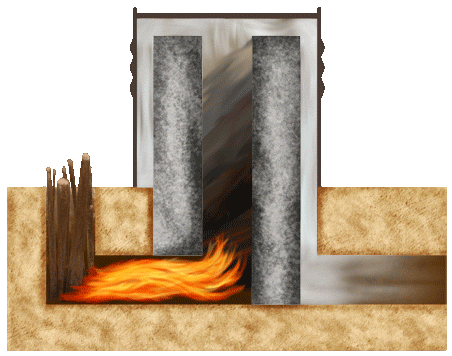Rocket Mass Heaters, also known by the acronym RMH, are the latest rage when it comes to extremely efficient and sustainable heating methods using low tech materials and basic workmanship.
Even if the name sounds pretty high tech (I mean the Rocket part), Rocket Mass Heaters are not complicated and in certain situations, it may cost next to nothing to build them. Well, next to nothing considering the benefits of such a device, including the amount of money you’ll save on your heating bill during cold months.
Why are they called Rocket Mass Heaters, you may ask? Well, the term simply comes from the swoosh sound they make while the fire is burning. RMHs benefit from a very intelligent design which is inspired, in my humble opinion naturally, from the after-burners in jet engines. You are familiar with afterburners, right? They work by injecting additional fuel into the jet pipe downstream to the turbine, thus increasing thrust, power and what not.
RMH works…well, somewhat similarly.
What Makes a Rocket Mass Heater Different from a Regular Stove?
There are stories about people claiming that they managed to heat their homes during the winter months using just the dead branches fallen in their backyard from the trees. It sounds like a Stig story (you know, that legendary and mysterious pilot from the auto-show Top Gear). But it may be true, because RMHs, due to their intelligent and highly efficient design, are capable of heating a home using up to 90% less wood than a conventional stove.
Amazing, right?
The main components in a RMH exhaust are CO2 and steam plus a bit of smoke  when you start the fire. The RMHs burn so clean that there are lots of people using them illegally (with a few exceptions like Oregon). If memory serves, there are no building codes yet for RMH hence if you’re using them, you may use them inside city limits without getting in trouble or even being detected!
when you start the fire. The RMHs burn so clean that there are lots of people using them illegally (with a few exceptions like Oregon). If memory serves, there are no building codes yet for RMH hence if you’re using them, you may use them inside city limits without getting in trouble or even being detected!
The heat from a RMH is highly residual, meaning that it will last for days in a well insulated house with a well designed RMH. And the best part is that you can build your own RMH in a couple of days for as low as a few hundred dollars.
Yes, I know, it sounds too good to be true, right?
When you’re first confronted with somebody talking about RMH, you’re perplexed. I mean, the firewood stands straight up, the fire burns horizontally and sideways, the exhaust pipe is cool and clean, there’s no smoke coming back up and the heat lasts for days. That’s great, but how does it work?
Basically, an RMH is a high performance, clean, highly efficient wood burner that can be built using recycled materials and/or natural materials like cob. You don’t have to be a professional and you don’t need complex masonry skills. This is a basic DIY job for the average Joe, any day of the week.
What makes the RMH different from your regular wood stove is the heat riser, which acts like a combustion chamber. The heat riser is well insulated and gets very hot, creating a powerful convective current, making the fire burn sideways and sucking up the smoke. The heat riser gets so hot that all the smoke particulate gets burned, hence the squeaky clean exhaust (co2 and steam). 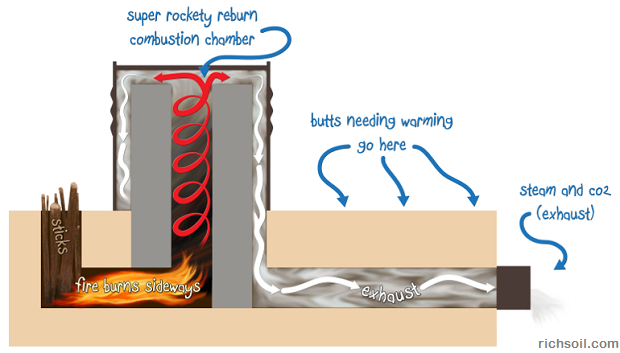 After the wood is burned with great efficiency at high temperatures thanks to the insulated combustion chamber (the heat riser), the exhaust gases pass through a large thermal mass (usually made of cob but it can be anything, such as brick, stone, tile or masonry) that absorbs the heat before the gases escape outside. The RMH is fueled with small pieces of wood, like trimmings from your back yard or dead tree branches or whatever. Here’s an exhaustive plan for building a RMH, one of the most detailed I could find:
After the wood is burned with great efficiency at high temperatures thanks to the insulated combustion chamber (the heat riser), the exhaust gases pass through a large thermal mass (usually made of cob but it can be anything, such as brick, stone, tile or masonry) that absorbs the heat before the gases escape outside. The RMH is fueled with small pieces of wood, like trimmings from your back yard or dead tree branches or whatever. Here’s an exhaustive plan for building a RMH, one of the most detailed I could find: 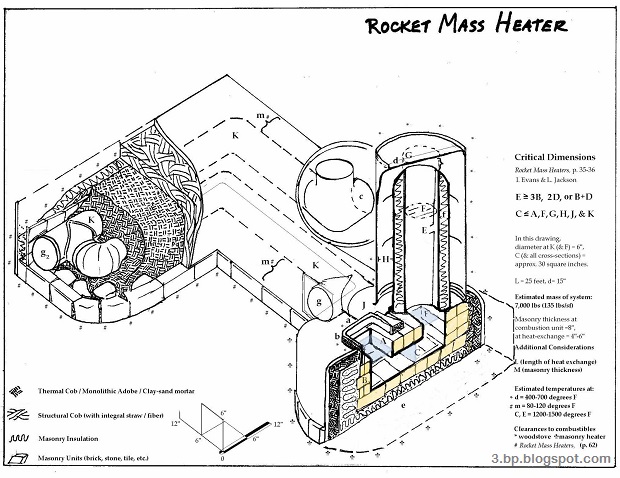
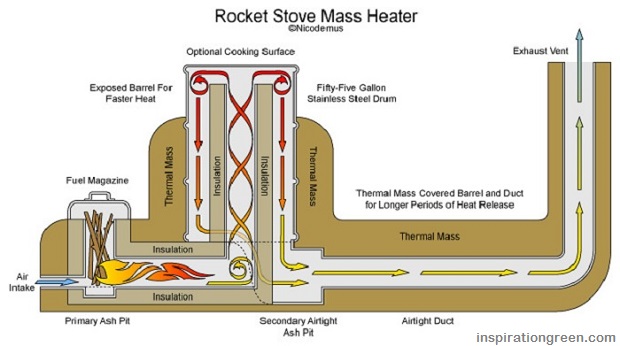 Now, if you’re already using wood to heat your residence, you should definitely consider DIY-ing an RMH; it will make a huge difference both in terms of comfort and woodpile shrinkage. Here’s a video tutorial which can be a great starting point for your future project:
Now, if you’re already using wood to heat your residence, you should definitely consider DIY-ing an RMH; it will make a huge difference both in terms of comfort and woodpile shrinkage. Here’s a video tutorial which can be a great starting point for your future project:
Video first seen on Green Energy Futures
There are advantages and disadvantages to any situation in life, as my uncle told me when his mother in law died and he had to pay for the funeral.
RMHs come with some obvious advantages, like high efficiency, low pollution, they produce large amounts of heat for a long time and they save you lots of money on your heating bill.
Also,they can look really nice, they use small pieces of wood that are commonly found in your backyard i.e. you don’t have to chop logs, they protect the forest (you don’t have to cut down trees), are easy to clean, heat up fast and cost you less. There is a flipside to that coin. Here are some cons: RMHs need to be tended more frequently than regular stoves (small pieces of wood burn fast), you must build thermal mass for acquiring efficiency and that takes up space, they burn less (45 minutes) than conventional stoves and you can’t enjoy the sight of a wood fire because it’s not visible. Also, they are labor intensive to build when compared to a regular stove (that you can buy from your hardware store) and they’re somewhat tricky to build correctly.
Now, Let’s See About Another Important Matter: How Much Does It Cost to DIY Your Own RMH?
Well, ballpark estimates for this kind of job are very tricky, because “buying everything” means different things for different kinds of people. Some need professional help when building an RMH, others are capable of putting in their own elbow grease and so on.
There are also the foundation costs which vary greatly depending upon what is already there and your local building codes. There are other factors, like if you already have an existing slab it will cost you less.
The chimney cost also varies and depends on the size of your house. It may end up costing more than the rest of the RMH put together.
The piping, the bricks and all the other materials are also rough guesses, because you can buy them new from the hardware store or you can recycle old stuff you already own. Cost also depends on the dimensions of the thermal mass etc. New fire brick, for example, costs about $1.25-$3 per piece, but you can buy used at gravel yards for 25 cents per piece or get them free at construction demolition sites.
The same story goes with the barrel for the combustion chamber; you can get one for free or pay $10-$30 a piece used (they will require paint and debris removal) or up to $200-$300 per piece new, depending on your source.
The thermal mass is the wild card in this ballpark estimate, because it depends greatly upon the choice of materials used in its construction and also upon the workforce. To elaborate on this matter, let’s say that you use mineral soil clay from your own source plus sand (that’s $100 a load) plus hired work. That’s one scenario and it depends on many factors, including the cost of the materials and labor. If you use rocks and dirt from your own backyard and do it yourself, it will cost you next to nothing other than your spare time.
If you buy (you may need to) bagged clay, it costs anywhere between $5-$40, depending on the quality and the seller.
An educated guess about the costs of a DIY RMH project can be made only after contacting local suppliers for cost estimates. It really does just depend on the scale of your project.
There’s no upper limit, while the lowest limit is next to zero; that everything varies from case to case. If you have a lifelong dedication to spending your own time instead of money, you can DIY your own RMH with next to zero costs, but that’s rare. Otherwise, the cost can be anywhere between $1500 (new and recycled components + your own work)–$5000 (if you buy everything new, and use hired labor).
I must tell you that if you want to build your own RMH someday with minimal costs, start collecting some of the parts right now. Put wanted ads on Craigslist, get to know your local scrap metal businesses, search for local demolition projects, and start gathering your materials so that you have them when you’re ready to build.
If you’ve built your own RMH, please tell us about your experience with it in the comments section below.
This article has been written by Chris Black for Survivopedia.
If you found this article useful, please like our Facebook page and stay up to date with the latest articles.
Check out our survival and prepping solutions HERE
WHAT TO READ NEXT:
A RETURN TO THE OLD PATHS: HOW TO MAKE PEMMICAN LIKE THE NATIVE AMERICANS
20 LOST RECIPES FROM THE PIONEERS: WHAT THEY COOKED IN THEIR JOURNEY WESTWARD
SEVEN CLASSIC GREAT DEPRESSION ERA RECIPES GRANDMA USED TO MAKE
POTTED MEAT: A LOST SKILL OF LONG TERM MEAT STORAGE
BACK TO BASICS: HOW TO MAKE AND PRESERVE LARD
THE BEST WAY TO STOCKPILE VEGETABLES OFF-GRID
OLD FASHIONED PRESERVING-GRANDPA’S RECIPE FOR CURED SMOKED HAM
HOW TO MAKE GUNPOWDER THE OLD FASHIONED WAY
SURVIVAL HERBAL RECIPES FROM OUR ANCESTORS
OTHER USEFUL VIDEOS:
The 3 Pioneer Survival Lessons We Should Learn
The Most Effective Home Defense Strategies
Old School Hacks for Off-Grid Living
The Medical Emergency Crash Course
The Smart, Easy Way to Food Independence
How to Survive the Coming 100 Years Long Drought
Photo Sources & References:
http://www.richsoil.com/rocket-stove-mass-heater.jsp http://3.bp.blogspot.com/-QWG7nsvizHg/UHcrwHi7gSI/AAAAAAAAARg/IHfIYoWRdAw/s1600/RocketHeater6 http://www.permies.com/t/41377/rocket-stoves/Cost-Estimating-Rocket-Mass-Heaters

